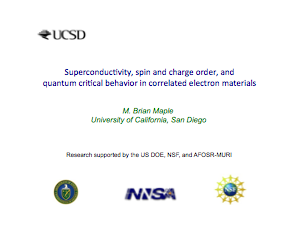Institute of Physics, Chinese Academy of Sciences


Jan 07-09, 2012

Superconductivity, spin and charge order, and quantum critical behavior
in correlated electron materials
M. B. Maple
Department of Physics, University of California, San Diego, USA
Multinary f-electron compounds have proven to be a rich reservoir of strongly correlated electron phenomena that arise from a delicate interplay between competing interactions. These interactions can be “tuned” by the variation of an external control parameter δ such as chemical composition x, pressure P or magnetic field H, resulting in complex electronic phase diagrams of temperature T vs. x, P or H. The suppression of the spin or charge ordered phase as a function of δ towards 0 K at a critical value δc is often accompanied by the emergence of superconductivity or an exotic magnetic phase, as well as anomalous normal state electronic properties that violate the Fermi liquid paradigm (so-called “non-Fermi liquid” behavior). For a 2nd order phase transition, order parameter fluctuations in the vicinity of δc (quantum critical point) are widely believed to be responsible for electron pairing in the superconducting phase, which often occurs in a “dome-shaped” region that envelops δc, and the non-Fermi liquid behavior in the normal state properties. Recent experiments in our laboratory that address the interrelation between superconductivity, various types of spin and charge order, and non-Fermi liquid behavior in novel f-electron materials are discussed.

click the picture to download
contact
Yi-feng Yang, Institute of Physics, Chinese Academy of Sciences, P. O. Box 603, Beijing 100190, China. Tel: (86)-10-82649448, (86)-18911600270; Fax: (86)-10-62553698; Email: yifeng@iphy.ac.cn


